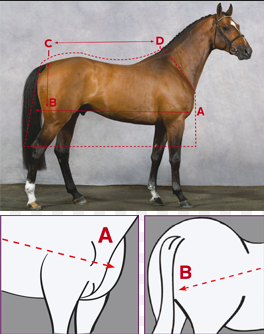Our eight easy steps to choosing and fitting the right blanket for your horse
Posted by Nicola Woodstock on 11th Feb 2016
Choosing a new blanket can be a minefield, so we’ve devised this handy guide to help you navigate your way through the confusing array of choice.
1. Choosing the right blanket
What your horse will be doing when wearing the blanket will likely dictate what type you buy. So ask yourself what the horse will be doing in its new blanket. Are you after a stable blanket, a turnout blanket, fly blanket, cooler, fleece or waffle? The varieties are seemingly endless, but deciding need not give you a headache.
Stable blankets are generally lighter and more manageable, while turnout blankets are more robust, and a good cooler comes in handy all year-round! If your horse spends time in the stable and turned out, you’ll need both stable and turnout blankets.
2. Measuring to buy
All brands differ slightly, but as a general rule, to measure what size will suit him best you should measure in a horizontal line from the middle of the horse’s chest to the point of buttock, next to the tail.
Blankets come in increments of 3 inches, so choose the closest to your measurement. For example, if your horse measures 72 inches (183cm) that’s equivalent to 6 foot — so start with trying that size on the horse.
3. Checking the fit
Once you have the blanket, check the size by putting it on and doing up the front closures. It should sit snugly over the quarters without too much sticking out of the back of the blanket, but without reams of material hanging off the back. If you aren’t sure whether the blanket will fit, make sure you try it on over another (thin) blanket, in case you need to change it.
Blankets mustn’t be too tight over the withers, otherwise your horse is sure to have a patch rubbed out of his mane. A badly fitting blanket can also cause bald patches on the shoulders — particularly with turnout blankets when the horse is moving around a lot in the field. Ensure you can get a hand down the front of the rug, at the chest, comfortably, and that it’s not pulling backwards.
4. Belly Straps
There are various design of belly straps, with the most common being two cross-surcingles, which cross under the horse’s tummy.
These straps need to be snug around your horse to prevent them getting their leg or hoof caught up — particularly when rolling. If too tight, they run the risk of rubbing.
5. Fittings across the bottom
The fitting at the back of the blanket will either be a fillet string or leg straps. These both work to stop the blanket moving or flipping up if it’s windy. If you have leg straps ensure you fasten left to left, right to right, looping through the middle as this keeps the straps from rubbing on their legs as well as helping to prevent hooves from getting caught when rolling.
6. Does my horse have specific requirements?
Big-moving horses or those with large shoulders benefit from blankets with front gussets. The gussets are triangular inserts cut into the blanket fabric to give the horse more space around the shoulder, allowing for more movement and minimizing rubs. Both gussets and leg arches — shaping around the leg areas — reduce the chance of rubbing.
Classically, two standard buckles were most common for the front fastenings, but there are increasingly more options on this front.
Many now mirror the design on most cross-surcingles and there are one or two of these at the chest. These days, many normal buckle fastenings have been improved by the addition of a quick-clip — they are easy to open and close, even when wearing blanket.
One note of caution though; always do the clip up with the opening facing into the horse. Otherwise you might be amazed by what your horse can manage to clip himself to — particularly in the field. Be particularly careful if there is any wire in the vicinity.
The V front closure is formed of two buckles that attach to one clip. The advantage of this is that it brings the rug together from the point of the shoulder allowing for greater freedom.
7. When should you consider a neck cover
In deepest darkest winter — and particularly with clipped horses — it’s a good idea to consider using a neck blanket or a neck cover added to your existing blanket. It will keep the horse warm and cleaner!
8. Caring for your blanket
All blankets on the market today are designed to be washed — many of them in the washing machine at home. Otherwise, having your blanket washed (and reproofed if they are turnouts) each year is a good idea — plus they can stay in the bag until you need them, making storage easier.
We really hope this helps and if you have any other questions please call us on 1 800 969 6584.



